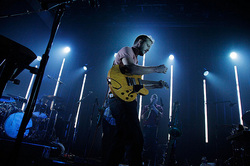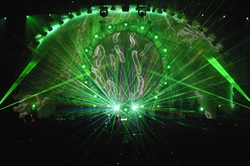Written by Ted There are few things I enjoy more than sitting back in a dark room with a vinyl copy of Pink Floyd's Dark Side of the Moon blasting away on a fine set of stereo speakers and drifting away to the furthest recesses of my mind. No matter how many times I listen to it, there's always a subtle nuance I missed in the previous listenings. Being one of the greatest albums of all time, Dark Side is in a league of its own - as most Floyd albums are. As much as I love jamming out to Floyd and their timeless music, it wasn't just their songs that made them one of the greatest bands of the 20th century. What sets Floyd apart from nearly every other group is their live show. The lasers, the stunning lighting and visuals, and above all, their dedication to give the audience an absolutely mind-bending experience. This concept is exactly what Floyd understood better than nearly anyone: that the live performance is the perfect way to give back to their fans, to say "Thank you for the support, now sit back and enjoy exactly what that means to us". More than its use as a way to give back to fans, one of the most critical elements to the live performance is that it reminds us that artists are human. Studio albums are easy to listen to because they're "mistake free". A great producer can easily correct the blemishes of the artist, so much so, that on the truly great albums it's impossible to know where the artist ended and the producer began. Truly, these masterpieces are a joy to behold. However, when you hear your favorite musician give it a go without the safety net of multiple takes and a talented producer, it becomes easy to glimpse the human behind the music, definitively showing the heart and soul that has been put into their craft. This, above all, demonstrates the artist’s willingness to connect with their audience. Additionally, live performance exposes when an artist is just going through the motions. It’s all too common for an artist to be late to their own show (looking at you, Justin Bieber) and seemingly not to give a rats about their fans (still looking at you, Biebs). The worse offense is hitting the stage too drunk to remember the words or be so high that only dogs can hear them. In a perfect world, concert goers would receive a full refund if they were in attendance of such a show. Conversely, like Pink Floyd, there are artists that achieve another plane of being with their live performances. Grammy-winning Bon Iver, an indie project band founded by the talented Justin Vernon, delivers live shows that are specifically meant to capture the audience’s rapt attention by delivering new arrangements on many of their songs. It is live that the audience comes to the stunning revelation that their songs, such as the hit Skinny Love, were meant to be sung as loudly as possible, by as many people as possible, and in as in an intimate setting as possible. Moreover, Vernon and his gifted cadre of multi-instrumental musicians have set about making sure that with each venue in which they perform, the audience - regardless of its size - will feel that intimacy, that connection to the music as Bon Iver does. When discussing Skinny Love In an interview with Pitchfork, Vernon was quoted as saying, “"I don't want to be the guy with an acoustic guitar singing songs, because that's boring for the most part. The song actually needs 80–500 people singing or whatever the vibe is of that room, it needs that fight.” To that end, Bon Iver delivers with each live performance a high quality version of their catalogue that is unlike anything found on the studio albums. New instruments and vocals will be woven in, or taken out and replaced by a simple stomp-clap arrangement by the 9-member band. They may ramp up the energy on a song that previously may have been a perfect fit to a sombre mood on a snowy day, without taking away any of its feeling. Above all, they encourage the audience to belt out the songs, to connect, to feel, and go home with a head full of beautiful music that will likely not be duplicated for another audience, but rather reinvented.  With apologies to the generic, run-of-the-mill lip-syncing pop star, this is one of the great failings of that genre. Sure, they may put on a sexy, elaborate stage show with costumes and pageantry, but odds are that the song heard on stage will be identical to the one their fans bought on iTunes. There likely won’t be that extra twist, that guitar solo that gets stretched for days, or that really well known song that gets turned on its head, just to keep the crowd guessing. When the lead singer’s voice starts cracking with emotion because they, like their audience, are completely wrapped up in the song - these are the things that create nostalgic memories cherished for a lifetime. I humbly submit my hypothesis that this is one of the top reasons that pop music doesn’t endure the long count of years as well: the personal connection to the listener just isn’t there. Simply put, the live show is the measure of an artist, the gold standard that separates a talented musician from being merely a performer. It’s not even that hard to tell them apart; for many performers, their music is written by some ghostly song-writer no one could recognize on the street. The connection to the emotion of the material is only incidental; the song is not a conduit of their raw emotion and experiences. Or perhaps they’re just trying to catch the coat-tails of a fad, full of catchy riffs but bereft of substance and authenticity. When an artist becomes a musician, they will put on a show to remember them by, one that will show you their heart, soul, talent, and above all, appreciation of those who come in droves to see them play. It’s what Pink Floyd has shown its fans through the decades; what Bon Iver strives to do every time they take the stage. It’s what makes a musician, and us, feel human.
0 Comments
Leave a Reply. |
Archives
August 2024
Categories |
|
© 2012-2025, Nerds That Geek LLC.
All Rights Reserved. |
uWeb Hosting by FatCow

 RSS Feed
RSS Feed